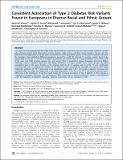| dc.contributor.author | Waters, Kevin M. | |
| dc.contributor.author | Stram, Daniel O. | |
| dc.contributor.author | Hassanein, Mohamed T. | |
| dc.contributor.author | Le Marchand, Loïc | |
| dc.contributor.author | Wilkens, Lynne R. | |
| dc.contributor.author | Maskarinec, Gertraud | |
| dc.contributor.author | Monroe, Kristine R. | |
| dc.contributor.author | Kolonel, Laurence N. | |
| dc.contributor.author | Henderson, Brian E. | |
| dc.contributor.author | Haiman, Christopher A. | |
| dc.contributor.author | Altshuler, David Matthew | |
| dc.date.accessioned | 2011-03-08T18:59:59Z | |
| dc.date.issued | 2010 | |
| dc.identifier.citation | Waters, Kevin M., Daniel O. Stram, Mohamed T. Hassanein, Loïc Le Marchand, Lynne R. Wilkens, Gertraud Maskarinec, Kristine R. Monroe, et al. 2010. Consistent association of type 2 diabetes risk variants found in Europeans in diverse racial and ethnic groups. PLoS Genetics 6(8): e1001078. | en_US |
| dc.identifier.issn | 1553-7390 | en_US |
| dc.identifier.uri | http://nrs.harvard.edu/urn-3:HUL.InstRepos:4739301 | |
| dc.description.abstract | It has been recently hypothesized that many of the signals detected in genome-wide association studies (GWAS) to T2D and other diseases, despite being observed to common variants, might in fact result from causal mutations that are rare. One prediction of this hypothesis is that the allelic associations should be population-specific, as the causal mutations arose after the migrations that established different populations around the world. We selected 19 common variants found to be reproducibly associated to T2D risk in European populations and studied them in a large multiethnic case-control study (6,142 cases and 7,403 controls) among men and women from 5 racial/ethnic groups (European Americans, African Americans, Latinos, Japanese Americans, and Native Hawaiians). In analysis pooled across ethnic groups, the allelic associations were in the same direction as the original report for all 19 variants, and 14 of the 19 were significantly associated with risk. In summing the number of risk alleles for each individual, the per-allele associations were highly statistically significant (P less than 10−4) and similar in all populations (odds ratios 1.09–1.12) except in Japanese Americans the estimated effect per allele was larger than in the other populations (1.20; Phet = 3.8×10−4). We did not observe ethnic differences in the distribution of risk that would explain the increased prevalence of type 2 diabetes in these groups as compared to European Americans. The consistency of allelic associations in diverse racial/ethnic groups is not predicted under the hypothesis of Goldstein regarding “synthetic associations” of rare mutations in T2D. | en_US |
| dc.language.iso | en_US | en_US |
| dc.publisher | Public Library of Science | en_US |
| dc.relation.isversionof | doi:10.1371/journal.pgen.1001078 | en_US |
| dc.relation.hasversion | http://www.ncbi.nlm.nih.gov/pmc/articles/PMC2928808/pdf/ | en_US |
| dash.license | LAA | |
| dc.title | Consistent Association of Type 2 Diabetes Risk Variants Found in Europeans in Diverse Racial and Ethnic Groups | en_US |
| dc.type | Journal Article | en_US |
| dc.description.version | Version of Record | en_US |
| dc.relation.journal | PLoS Genetics | en_US |
| dash.depositing.author | Altshuler, David Matthew | |
| dc.date.available | 2011-03-08T18:59:59Z | |
| dash.affiliation.other | HMS^Medicine-Massachusetts General Hospital | en_US |
| dash.affiliation.other | HMS^Genetics | en_US |
| dc.identifier.doi | 10.1371/journal.pgen.1001078 | * |
| dash.authorsordered | false | |
| dash.contributor.affiliated | Altshuler, David | |


